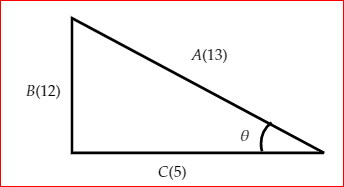
If \[A = B + C\] and the value of A, B, and C are 13, 12, and 5 respectively, then find the angle between A and C.
A.\[{\cos ^{ - 1}}\left( {\dfrac{5}{{13}}} \right)\]
B. \[{\cos ^{ - 1}}\left( {\dfrac{{13}}{{12}}} \right)\]
C. \[\dfrac{\pi }{2}\]
D. \[{\sin ^{ - 1}}\left( {\dfrac{5}{{12}}} \right)\]
Answer
127.8k+ views
Hints First we will apply the Pythagorean theorem to check whether the given triangle is a right-angle triangle or not. Then decide which are the legs and hypotenuse of the triangle. Then find the angle between B and C using the trigonometry ratios.
Formula used
The Pythagoras theorem for right angle is,
\[{a^2} + {b^2} = {c^2}\], where a is the base, b is the height, and c is the hypotenuse.
Also,
\[\cos \theta = \dfrac{p}{q}\], where p is the base and q is the hypotenuse.
Complete step by step solution
The given lengths of the sides are 13, 12, and 5.
Now,
\[{12^2} + {5^2}\]
\[ = 144 + 25\]
\[ = 169\]
\[ = {13^2}\]
Therefore, according to Pythagoras' theorem, the given triangle is right-angled.
The diagram of the given triangle is,

Use the formula \[\cos \theta = \dfrac{p}{q}\] , where p is the base and q is the hypotenuse to obtain the required result.
Therefore,
\[\cos \theta = \dfrac{5}{{13}}\]
\[\theta = {\cos ^{ - 1}}\left( {\dfrac{5}{{13}}} \right)\] .
The correct option is A.
Note Students often used cosine formula \[{A^2} = {B^2} + {C^2} + 2BC\cos \phi \] to obtain the angle between B and C and \[\theta\]. By using the cosine formula we cannot able find the angle between B and C. Because the cosine formula is applicable to an oblique triangle. Thus we will use trigonometry ratios to find the angle between them.
Formula used
The Pythagoras theorem for right angle is,
\[{a^2} + {b^2} = {c^2}\], where a is the base, b is the height, and c is the hypotenuse.
Also,
\[\cos \theta = \dfrac{p}{q}\], where p is the base and q is the hypotenuse.
Complete step by step solution
The given lengths of the sides are 13, 12, and 5.
Now,
\[{12^2} + {5^2}\]
\[ = 144 + 25\]
\[ = 169\]
\[ = {13^2}\]
Therefore, according to Pythagoras' theorem, the given triangle is right-angled.
The diagram of the given triangle is,

Use the formula \[\cos \theta = \dfrac{p}{q}\] , where p is the base and q is the hypotenuse to obtain the required result.
Therefore,
\[\cos \theta = \dfrac{5}{{13}}\]
\[\theta = {\cos ^{ - 1}}\left( {\dfrac{5}{{13}}} \right)\] .
The correct option is A.
Note Students often used cosine formula \[{A^2} = {B^2} + {C^2} + 2BC\cos \phi \] to obtain the angle between B and C and \[\theta\]. By using the cosine formula we cannot able find the angle between B and C. Because the cosine formula is applicable to an oblique triangle. Thus we will use trigonometry ratios to find the angle between them.
Recently Updated Pages
Difference Between Vapor and Gas: JEE Main 2024

Area of an Octagon Formula - Explanation, and FAQs

Difference Between Solute and Solvent: JEE Main 2024

Absolute Pressure Formula - Explanation, and FAQs

Carbon Dioxide Formula - Definition, Uses and FAQs

Charle's Law Formula - Definition, Derivation and Solved Examples

Trending doubts
JEE Main 2025 Session 2: Application Form (Out), Exam Dates (Released), Eligibility & More

JEE Main Exam Marking Scheme: Detailed Breakdown of Marks and Negative Marking

JEE Main 2025: Conversion of Galvanometer Into Ammeter And Voltmeter in Physics

JEE Mains 2025 Correction Window Date (Out) – Check Procedure and Fees Here!

Learn About Angle Of Deviation In Prism: JEE Main Physics 2025

JEE Main 2025: Derivation of Equation of Trajectory in Physics

Other Pages
JEE Advanced Marks vs Ranks 2025: Understanding Category-wise Qualifying Marks and Previous Year Cut-offs

Electromagnetic Waves Chapter - Physics JEE Main

Degree of Dissociation and Its Formula With Solved Example for JEE

Electric Field Due to Uniformly Charged Ring for JEE Main 2025 - Formula and Derivation

Current Loop as Magnetic Dipole and Its Derivation for JEE

Ideal and Non-Ideal Solutions Raoult's Law - JEE




